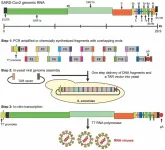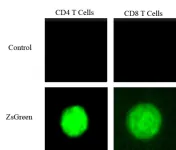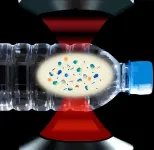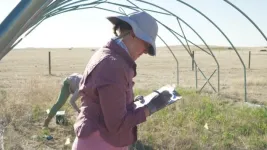(Press-News.org)
Research is shedding light and potentially expanding options for patients living with Medulloblastoma, an aggressive childhood cancer.
Medulloblastoma is a cancer impacting both very young and school aged children.
When children get this type of brain tumor, they experience the process of the tumor blocking flow of fluid around the brain.
This can cause severe headaches, vomiting, sleepiness, fussiness, and difficulty walking and coordinating movements.
Treatment is intense, involving high dose chemotherapy, surgery, and sometimes radiation or stem cell transplants.
During these months long treatments, children may lose hair, lose weight, be unable to eat and experience lots of upset stomachs.
Medulloblastoma is also a complex disease with many different genetic causes, making a one-size-fits-all approach to treatment impossible.
“Unfortunately, many patients with certain forms of medulloblastoma do not respond well to treatment,” said John Prensner, M.D., Ph.D., Assistant Professor of Pediatrics and Biological Chemistry and one of the study’s senior authors.
“This research is critical in helping us begin to understand how medulloblastoma works on a genetic and cellular level so that patients can be treated, and new therapies can be developed, accordingly.”
The research
Prensner’s group paired up with the team of Sebastiaan van Heesch, Ph.D., research group leader at the Princess Máxima Center for pediatric oncology in the Netherlands, to examine several groups of patients, some of which experienced the most aggressive form of the cancer and had the poorest outcomes.
Many of those patients had biological and genetic factors that exacerbated their cancers, including the cancer gene MYC.
Prensner’s team and their collaborators took a new hypothesis on how MYC might be functioning and how that might be implicated in cancer.
“The twist that we put on it is to ask the question, what if this MYC is doing important functions outside of what we know to be genes in these cancer cells?” Prensner said.
Damon Hofman, a Ph.D. student in the Van Heesch group at the Princess Máxima Center and one of the first authors of the study, added: “For the first time, we identified and studied the role of essential microproteins in medulloblastoma.
“The micro-protein ASNSD1-uORF appeared to be essential for MYC cancer cells. The fact that these previously overlooked tiny proteins are so important for the survival of this kind of cancer cell is fascinating and underscores the importance of expanding research into other childhood cancers.”
With further understanding of MYC and other genetic, biological, and cellular factors, providers can then learn how to intervene with these cancers.
Furthermore, the research could support development of therapeutics that could target the molecular process allowing cancer cells to grow.
This study may be newer, but Prensner’s interest in medulloblastoma is not.
His experience began early when he was a medical student; he was moved by the patients he met who were living with the tumor.
“I've never forgotten, not just the patients, but the families. That's why it's been so important to me to try to use the interests and training that I have in the scientific fields to think about how we can really unlock new areas of understanding about this disease to get these patients better choices,” he said.
“Translation of non-canonical open reading frames as a cancer cell survival mechanism in childhood medulloblastoma,” Molecular Cell. DOI: 10.1016/j.molcel.2023.12.003
END
Despite an alarming increase in overdose deaths among young people nationwide, a new “secret shopper”-style study led by Oregon Health & Science University researchers finds that access to residential addiction treatment centers for adolescents in the United States is limited and costly.
The study, published today in the January issue of the journal Health Affairs, found that about half of the sites reported a wait time, and among those the average wait was almost a month. For those who do manage to find a placement, the average daily cost is $878 — with close to half of the facilities that provided information requiring partial or full payment upfront. For the average ...
Access to residential addiction treatment centers caring for U.S. adolescents under 18 years old in the United States is limited and costly, according to a new study supported by the National Institutes of Health. Researchers found that only about half (54%) of the residential addiction treatment facilities that they contacted had a bed immediately available, and for those that had a waitlist, the average estimated time before a bed opened was 28 days. In addition, the average daily cost per day of treatment was $878, with close to half (48%) of the facilities that provided information requiring partial or full payment upfront. ...
“TAR cloning is used to genetically engineer synthetic viruses with novel properties that may be used for the development of new vaccines.”
BUFFALO, NY- January 8, 2024 – A new review paper was published in Oncotarget's Volume 14 on December 22, 2023, entitled, “Transformation-associated recombination (TAR) cloning and its applications for gene function; genome architecture and evolution; biotechnology and biomedicine.”
Transformation-associated recombination (TAR) cloning represents a unique tool to selectively and efficiently recover a given chromosomal segment up to several hundred ...
UNIVERSITY PARK, Pa. — Mobile phones pack a lot of information into pocket-sized devices, which is why users may want to slow down the next time they’re scrolling through social media or checking email on a mobile app. People process information more efficiently but tend to be less vigilant about misinformation on their mobile phones compared to personal computers (PCs), according to a team led by Penn State researchers. This is especially true for users who have developed a routine or habit of using their ...
AMHERST, Mass. – In a first-of-its-kind research breakthrough, a team of scientists at the University of Massachusetts Amherst has analyzed and described what they call the “mosquito effect,” which sheds light on how certain pathogens, such as cancerous tumor cells, can outwit the body’s immune system.
Just as mosquitoes ingest their host’s blood, the immune system’s T cells incorporate cytoplasmic material from tumors into their own cytoplasm. While it has long been known that many kinds of cells can transfer cellular material from one to another, the transfer of the cytoplasm has never been observed in T cells. Subsequent single-cell RNA (scRNA) ...
Researchers have developed a new soft robot design that engages in three simultaneous behaviors: rolling forward, spinning like a record,and following a path that orbits around a central point. The device, which operates without human or computer control, holds promise for developing soft robotic devices that can be used to navigate and map unknown environments.
The new soft robots are called twisted ringbots. They are made of ribbon-like liquid crystal elastomers that are twisted – like a rotini ...
In recent years, there has been rising concern that tiny particles known as microplastics are showing up basically everywhere on Earth, from polar ice to soil, drinking water and food. Formed when plastics break down into progressively smaller bits, these particles are being consumed by humans and other creatures, with unknown potential health and ecosystem effects. One big focus of research: bottled water, which has been shown to contain tens of thousands of identifiable fragments in each container.
Now, using newly refined technology, researchers have entered a whole ...
The body’s immune response to Epstein-Barr virus (EBV) may play a role in causing damage in people with multiple sclerosis, according to a new study led by UTHealth Houston.
EBV infection has long been associated with multiple sclerosis, but how the infection might contribute to multiple sclerosis has not been clear. More than 95% of people have been infected with this very common virus; however, it typically remains in its latent stage and doesn’t cause any issues. In some cases, though, the T-cells specific for the EBV infection may cause ...
EMBARGO: THIS CONTENT IS UNDER EMBARGO UNTIL 3 P.M. U.S. EASTERN STANDARD TIME ON JANUARY 8. INTERESTED MEDIA MAY RECIVE A PREVIEW COPY OF THE JOURNAL ARTICLE IN ADVANCE OF THAT DATE OR CONDUCT INTERVIEWS, BUT THE INFORMATION MAY NOT BE PUBLISHED, BROADCAST, OR POSTED ONLINE UNTIL AFTER THE RELEASE WINDOW.
A global study organized and led by Colorado State University scientists shows that the effects of extreme drought – which is expected to increase in frequency with climate change – has been greatly underestimated for grasslands and shrublands.
The findings – published in Proceedings of the National Academy of Sciences – quantify the impact of extreme ...
Researchers at McMaster University have discovered a molecular “barcode” system used by disease-causing bacteria to distinguish between beneficial and toxic molecules.
Published in the Proceedings of the National Academy of Sciences (PNAS), the new study shows that many bacteria can figuratively scan genetic codes to learn which proteins to keep and which proteins to expel into the environment.
According to researchers, those proteins that are expelled are often toxic to human cells, making the ...





